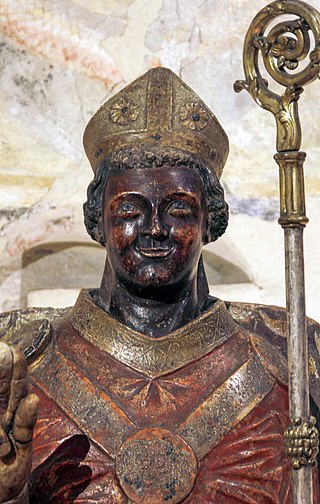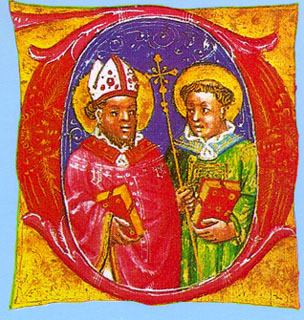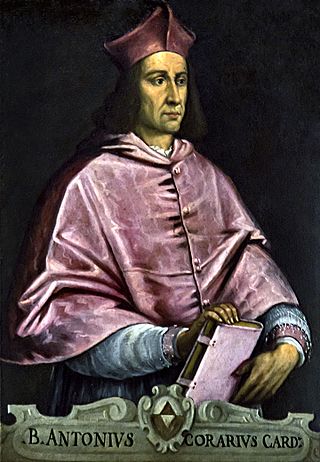
Martin of Tours, also known as Martin the Merciful, was the third bishop of Tours. He has become one of the most familiar and recognizable saints in France, heralded as the patron saint of the Third Republic. He is the patron saint of many communities and organizations across Europe. A native of Pannonia, he converted to Christianity at a young age. He served in the Roman cavalry in Gaul, but left military service at some point prior to 361, when he became a disciple of Hilary of Poitiers, establishing the monastery at Ligugé. He was consecrated as Bishop of Caesarodunum (Tours) in 371. As bishop, he was active in the suppression of the remnants of Gallo-Roman religion, but he opposed the violent persecution of the Priscillianist sect of ascetics.
Pope Silverius was bishop of Rome from 8 June 536 to his deposition in 537, a few months before his death. His rapid rise to prominence from a deacon to the papacy coincided with the efforts of Ostrogothic king Theodahad, who intended to install a pro-Gothic candidate just before the Gothic War. Later deposed by Byzantine general Belisarius, he was tried and sent to exile on the desolated island of Palmarola, where he starved to death in 537.

Todi is a town and comune (municipality) of the province of Perugia in central Italy. It is perched on a tall two-crested hill overlooking the east bank of the river Tiber, commanding distant views in every direction. It was founded in antiquity by the Umbri, at the border with Etruria; the gens Ulpia of Roman emperor Trajan came from Todi.

Martial, called "the Apostle of the Gauls" or "the Apostle of Aquitaine", was the first bishop of Limoges. His feast day is 30 June.

Germain was the bishop of Paris and is venerated as a saint in both the Catholic Church and the Eastern Orthodox Church. According to an early biography, he was known as Germain d'Autun, rendered in modern times as the "Father of the Poor".

Venantius Honorius Clementianus Fortunatus, known as Saint Venantius Fortunatus, was a Latin poet and hymnographer in the Merovingian Court, and a bishop of the Early Church who has been venerated since the Middle Ages.

Gregory Thaumaturgus or Gregory the Miracle-Worker, also known as Gregory of Neocaesarea, was a Christian bishop of the 3rd century. He has been canonized as a saint in the Catholic and Orthodox Churches.

Zeno of Verona was an Afro-Italian Christian figure believed to have either served as Bishop of Verona or died as a martyr. He is venerated as a saint in the Catholic Church and the Orthodox Church.

February 22 - Eastern Orthodox liturgical calendar - February 24

Prosper of Reggio is an Italian saint. Tradition holds that he was a bishop of Reggio Emilia for twenty-two years. Little is known of his life, but documents attest that he was indeed bishop of Reggio Emilia in the fifth century.

Saint Albinus of Angers, also known as Saint Albin in English, was a French abbot and bishop. Born to a noble Gallo-Roman family at Vannes, Brittany, St. Albinus was a monk and from 504 A.D. Abbot of Tintillac. His reputation spread during the twenty-five years in which he served as abbot. In 529, St. Albinus was elected, against his wishes, Bishop of Angers.

Dacius or Datius was Bishop of Milan from c. 530 to 552. He is honoured as a saint in the Catholic Church and in the Orthodox Church.

Simon Rinalducci of Todi was a famous Italian Augustinian friar and preacher of the 13th century.
Felix of Bourges was a bishop of Bourges who later became recognized as a saint.

Hermagoras of Aquileia is considered the first bishop of Aquileia, northern Italy. Christian tradition states that he was chosen by Mark to serve as the leader of the nascent Christian community in Aquileia, and that he was consecrated bishop by Peter. Hermagoras and his deacon Fortunatus evangelized the area but were eventually arrested by Sebastius, a representative of Nero. They were tortured and beheaded.

Antonio Correr was a Roman Catholic Cardinal who was appointed cardinal by his uncle Pope Gregory XII during the period of the Great Western Schism.

Saint Fortunatus of Spoleto was a parish priest near Spoleto in Umbria sometime between the 4th and 5th centuries. He is venerated as a saint within the Catholic Church.
Fortunatus of Casei is venerated as a saint by the Catholic Church. Tradition makes him a member of the Theban Legion, and thus martyred at Agaunum. However, his relics were situated in the catacombs of Pope Callixtus I in Rome until 1746, when Cardinal Guadagni, Roman vicar to Benedict XIV, re-exhumed and displayed Fortunatus’ relics in the collegiate church of Santa Maria in Via Lata in Rome. It is unclear how the relics of Fortunatus reached Rome from the saint's supposed place of death in the Swiss Alps.

October 13 - Eastern Orthodox liturgical calendar - October 15

San Fortunato is a Gothic- and Renaissance-style, Roman Catholic church located on Piazza Umberto I #6 in the historic center of Todi, province of Perugia, region of Umbria, Italy.


















